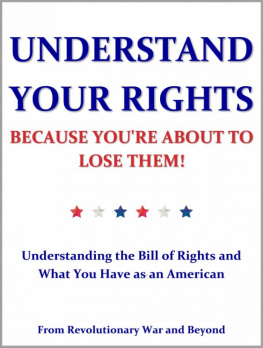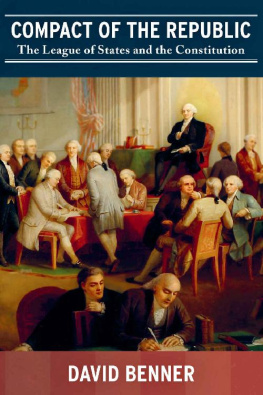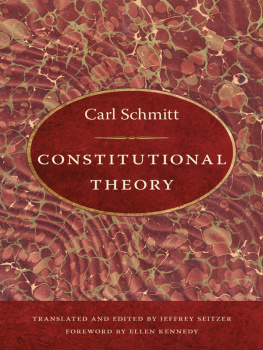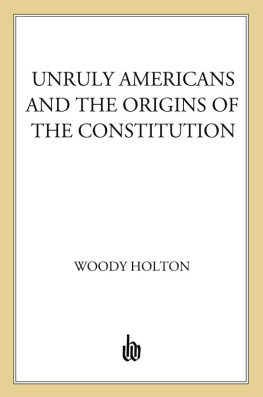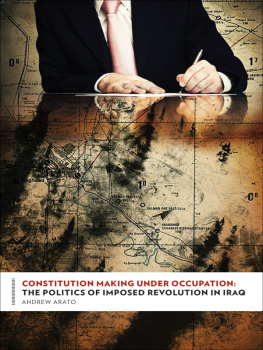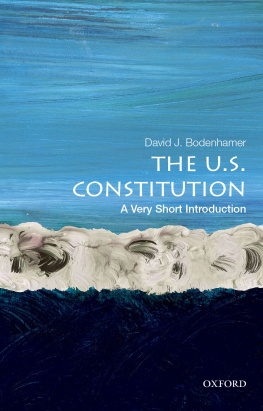Between Authority & Liberty
In all governments, there is a perpetual intestine struggle, open or secret, between AUTHORITY and LIBERTY; and neither of them can ever absolutely prevail in the contest. A great sacrifice of liberty must necessarily be made in every government; yet even the authority, which confines liberty, can never, and perhaps ought never, in any constitution, to become quite entire and uncontroulable.
David Hume
Of the Origin of Government
1997 The University of North Carolina Press
All rights reserved
Manufactured in the United States of America
The paper in this book meets the guidelines for permanence and durability of the Committee on Production Guidelines for Book Longevity of the Council on Library Resources.
Library of Congress Cataloging-in-Publication Data Kruman, Marc W.
Between authority and liberty : state constitution making in revolutionary America / by Marc W. Kruman. p. cm. Includes bibliographical references and index.
ISBN 0-8078-2302-3 (cloth: alk. paper)
ISBN 0-8078-4797-6 (pbk.: alk. paper)
1. Representative government and representationUnited StatesHistory. 2. United StatesConstitutional history. 3. United StatesPolitics and government1775-1783. 4. Political scienceUnited StatesHistory. I. Title.
JK2484.K78199696-11615
320.473dc20CIP
03 02 01 00 99 6 5 4 3 2
Preface
This book originated as a study of the right to vote in the United States from the Revolution to Reconstruction. I began, logically enough, with the revolutionary state constitutions. Because of the availability of several recent studies of revolutionary constitutionalism, especially Gordon Woods magnificent The Creation of the American Republic, I expected to devote little time to revolutionary-era documents. I supposed that my work in primary sources would simply confirm Woods findings. Generally, Wood argues that the revolutionary republican belief in a homogeneous people virtuously committed to the common good precluded attention to voting rightsthe embodiment, after all, of atomistic self-interest. In the states, the interests of the representative and his constituency were presumed to be the same. What benefited or injured one, supposedly benefited or injured the other. Therefore, the disfranchised were as well represented as the electors. Only when wartime conflict drowned out consensus did Americans exalt voting and direct representation.
Because Woods arguments are elegant and based upon considerable evidence, I was surprised when my own research led me in other directions. Rather than believing in 1776 that the legislature embodied the popular will, revolutionary republicans often treated legislators as mistrusted delegates to a potentially tyrannical government. They expected the people to watch carefully over the actions of their representatives through broad suffrage eligibility and annual elections.
Such is the power of Woods brilliant work that I resisted my own conclusions. In my initial draft of the suffrage books first chapter, now mercifully buried in the hard drive of my computer, I managed to stuff my incompatible research into Woods framework. But my dissatisfaction with the resulting mess compelled further inquiry.
I soon discovered other important areas of disagreement with Wood. He contends, for example, that revolutionary Americans faith in legislators as their representatives encouraged them to permit the legislatures or the quasi-legislative provincial congresses to write constitutions. Moreover, they viewed constitutions not as permanent documents that established and defined the limits of government power, but as expressions of legislative will subject to legislative revision. Aiming to restrain the magistrate, Wood continues, constitution makers entrusted almost all power to themselves as members of the legislatures. Because they successfully restricted gubernatorial powers in their constitutions, they paid scant attention to declarations of rights. In the declarations they did write, they further sought to constrain governors.
My research suggested otherwise. The constitution makers (outside of South Carolina in 1778) were not legislators, but members of provincial congresses (institutions very different from legislatures) or constitutional conventions. They perceived the constitutions, and the declarations of rights with which many were prefaced, as permanent documents designed to create the structures of government and to establish behavioral guidelines for men in power. From the first, the framers assumed the need to restrain all governmentlegislators no less than magistrates.
I also came to disagree with Woods explanation for the emergence of bicameral legislatures. In his estimation, bicameralism initially represented a continuation of the tradition that different parts of government represented different social estates. Ordinary Americans participated in government through the lower house of the legislature, as had ordinary Englishmen in the House of Commons. The peoples sovereignty was embodied in state legislatures. Only later, as Americans came to fear un-trammeled legislative power, did they conclude that bicameralism checked the arbitrary exercise of power by legislators. My reading of the evidence suggested, to the contrary, that, although constitution makers sometimes aimed to create some form of mixed government, they worried primarily about curbing the legislature. This was true in states adopting bicameral and unicameral legislatures.
From the earliest days of the Revolution, patriot leaders largely rejected the notion of an organic polity in favor of a mechanical polity. In the organic polity, representatives selflessly embodied and defended the whole people; in the mechanical polity, they hungered after power, endangered the peoples liberties, and were curbed by a vigilant citizenry at the polls. The mechanical polity depended upon a large and incorruptible electorate and deep-seated veneration of the right to vote. As revolutionaries abandoned the organic polity, they made voting the measure of legitimate representation. If representatives were potential tyrants, then the people needed to define and limit their authority through constitutions and declarations of rights.
Revolutionaries summarily rejected the idea that legislators might create the documents designed to restrain themselves. Instead, they lodged authority to write constitutions in temporary and extraordinary provincial congresses and constitutional conventions. Because representatives, like all men, yearned for ever greater power, they had to be hemmed in tightly by ensuring that the legislature represented all parts of a state, that representatives be elected annually, and that they live in the districts they represented. As a further consequence, lawmakers had to be constrained through mechanical devices such as a separation of powers, which parceled out power among different government branches and prevented the consolidation of power in any one branch, including the legislature. Also, in most states, constitution makers inhibited the lgislatures accumulation of unlimited power by dividing legislative power into two houses. Even in states with unicameral legislatures, the framers constructed numerous devices to restrain those assemblies.


